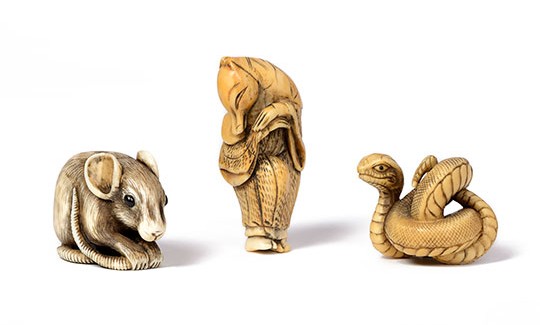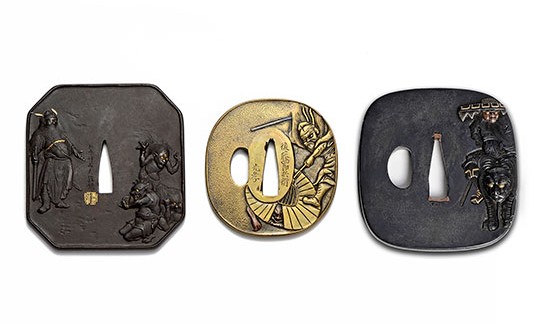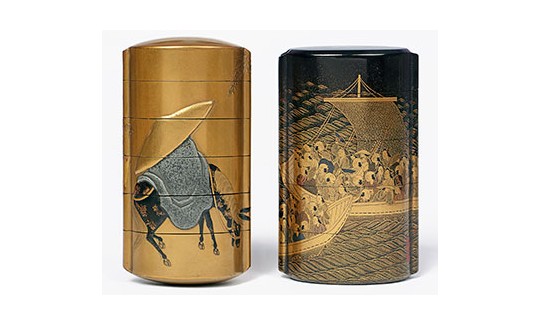Small IS BEAUTIFUL
“No matter what it is, all things small, are beautiful.”
Sei Shonagon (10th century)
Traditional Japanese art demonstrates the desire to embellish every tiny object, thus transforming it into an artistic work of aesthetic perfection. Moreover, the great, technical skill and accuracy of detail displayed by the Japanese artists do not interfere with individual expression or the interpretation of legends and folk or religious traditions. Motifs are depicted realistically, with humour and vividness, revealing a rich, folkloristic world that provides an inexhaustible source of information for comprehending the customs, symbols, fables and concepts of their period.
Over the centuries, the tendency evolved in Japan to value small objects over big ones and this for both practical and religious reasons. Since Japan is an island nation with limited resources and dense population, the use of large objects is not practical. In addition, the Buddhist perception of minimalism had extensive impact over a wide range of Japanese art forms.
The linguist Ôno Susumu (1919-2008) writes in his book "The Development of Aesthetic Consciousness and Japanese” (Biishiki no hattatsu to Nihongo, Tokyo: Risô-sha 483, 1973) that concepts exist in the Japanese language attesting to different values of beauty. One such concept expresses the sense that beauty resides in small, fine objects. Ôno argues that this tendency is at the centre of the Japanese word for beautiful, utsukushii.
The concept utsukushii, in its older form (utsukushi), existed already during the Heian period (794-1185). However, then it did not mean “beautiful" but rather something closely associated with it. This can be seen in the Manyôshû ("Collection of Ten Thousand Leaves") anthology of poetry, compiled in the 8th century, where the poet Yamanoue no Okura (ca. 660-733) praises his wife and children for being utsukushi, with the implied meaning of "loved”. The same word also appears in "The Story of the Bamboo Cutter" (Taketori monogatari, 10th century) and the "Pillow Book” (Makura no sôshi) written by Sei Shonagon (c. 966-1017 or 1025). According to her writings, the use of utsukushi signifies affection for small and fragile things. Shonagon writes: "No matter what, all things small are loved" (nani mo nani mo, chihisaki mono, mina utsukushi). In other words, utsukushi was an adjective that expressed affection for diminutive objects.
Japanese artists indeed exhibit a tendency to embellish every pocket-sized item, transforming it into an objet d'art of aesthetic perfection. This highly technical quality and accuracy of detail did not interfere with the artists’ individual expression and their interpretation of legends or of folk and religious traditions. The preference for subjects of small artworks provides us with an endless source for comprehension of the customs, symbols, fables and prevailing concepts of the period. The first artists, who designed and decorated small objects, produced sculptures of religious representations including deities, demons and spirits, legendary figures and human beings who had been deified. To these were added real and imaginary creatures, animate and inanimate forms connected with folklore. For instance, the eggplant which appears so often in miniature art is also a symbol associated with the Buddhist Bon Festival (Remembrance Day). On this day an eggplant is placed on the shelf used as the altar of souls. The mouse that decorates inrô (container for a seal), tsuba (sword hand guard), kozuka (small knife handle) and fuchi-kashira (sword hilt collar and butt cup) is one of twelve Sino-Japanese luck symbols and accompanies Daikoku, one of the seven gods of good fortune. Two mice signify the complementary elements of yin and yang. Since all of nature is sacred, according to the Japanese Shintô religion, and the gods are interconnected with the real world, the attitude towards those small objects is more than one of aesthetic appreciation. Small inrô cases, usually made of Japanese cypress and covered with many layers of lacquer, were used between the 17th and 19th centuries. The inrô is divided into several tiny compartments used for carrying seals and over the years also medicines and other small belongings. It was tied with a silk thread to the sash that fastened the kimono. Attached to the other end of the thread was the netsuke (carved, ornate accessory which attached various implements to clothing such as today's keychains sometimes do) whose function was to prevent the inrô from sliding out of the garment. A small bead (ojime; cord fastener) is threaded on the cord between the inrô and netsuke. Its purpose is to ensure that the container is sealed by sliding it towards the inrô. Other small utensils, such as the kogo (incense box), were designed and decorated by talented artists. Paintings embellishing those items represent a microcosm of nature. Netsuke figurines, usually made of wood or ivory, were only a few centimetres in size. Originally, netsuke (ne - root, tsuke - to attach), as is evident from the meaning, was a very simple object. But it very quickly became an object of artistic interest, a small artefact decorated with motifs taken from Japanese folklore, popular beliefs, religion and themes from the daily culture of the Edo period (1600-1868). The netsuke was used by men of all classes from the 16th century, but reached its peak during this period. Japanese artists went to great lengths to depict small things in great detail, making full use of the decorative arts such as lacquer, metalwork and wood. Those able to purchase these small objects of art undoubtedly appreciated the work invested in them that had no parallel. The spirit of tradition, which paid so much attention to small things, is still very much alive in Japanese industry as seen in figurines and simple objects that are attached by straps to handbags and mobile phones. It seems that these have replaced the traditional netsuke but it is the same affection for small details that dominates their forms.
Curator: Dr. Ilana Singer Blaine



